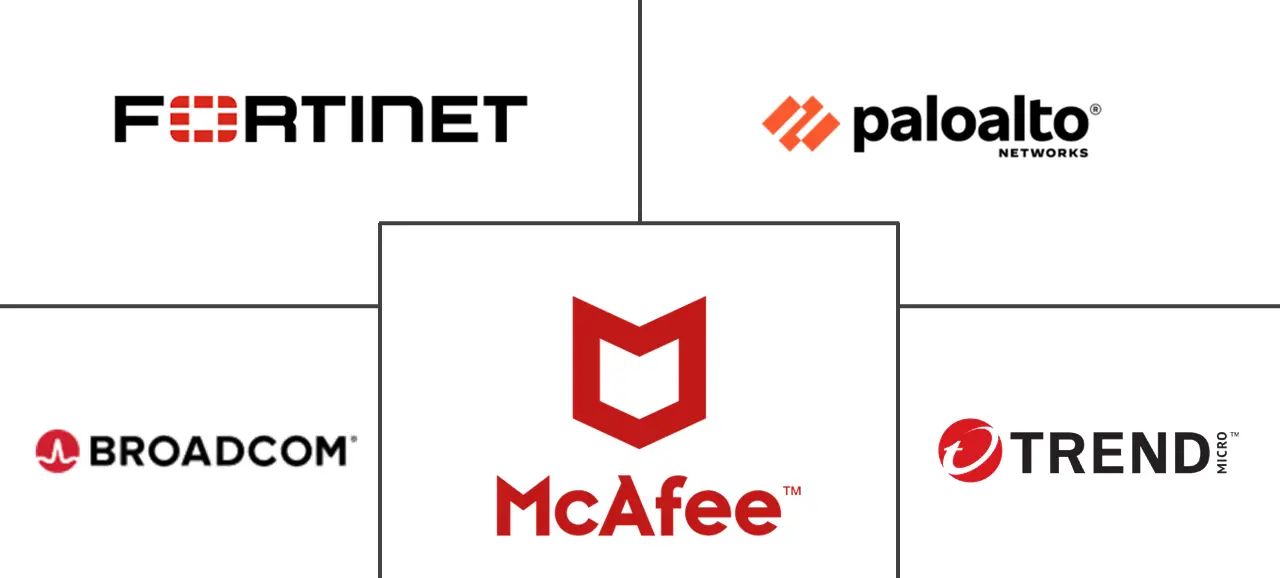Security Software Market Size and Share
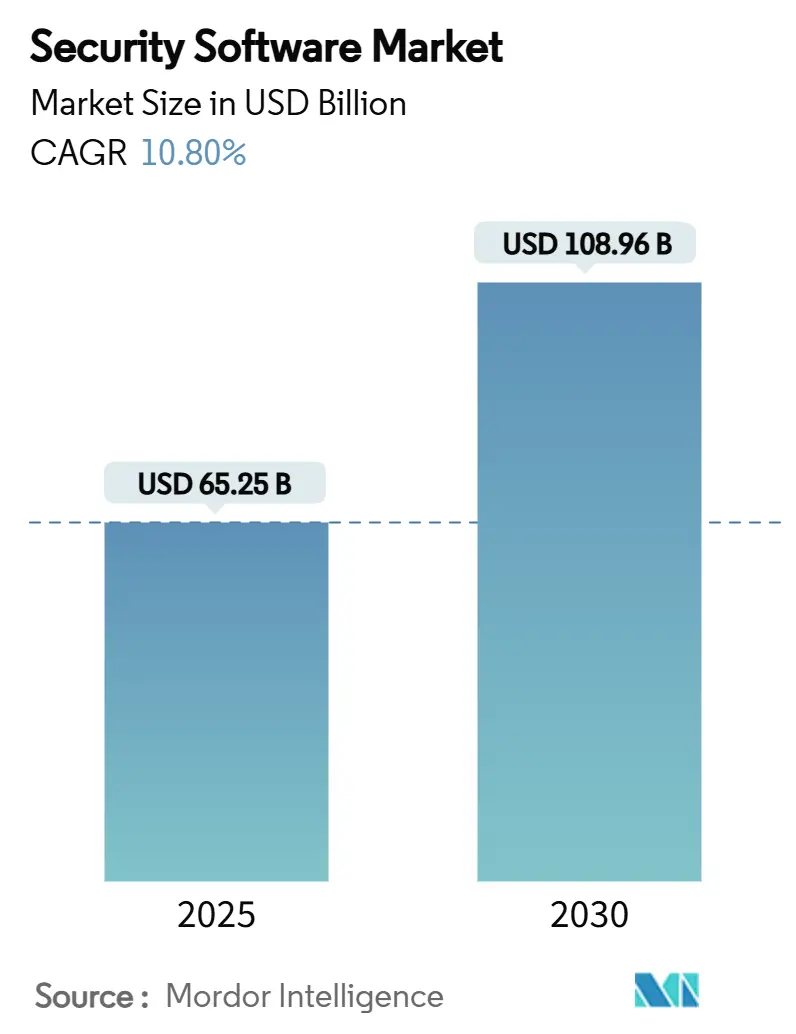
Security Software Market Analysis by Mordor Intelligence
The security software market is currently valued at USD 65.25 billion in 2025 and is projected to reach USD 108.96 billion by 2030, reflecting a healthy 10.8% CAGR over the forecast period. Robust demand stems from rising AI-enabled threats, new regulatory mandates, and the convergence of cyber-insurance with risk management, all of which are forcing organizations to invest in end-to-end security platforms. Identity-centric architectures, zero-trust adoption, and cloud workload protection are key themes reshaping vendor roadmaps. Spending momentum remains strongest in sectors with high compliance exposure, while small and medium enterprises (SMEs) are closing historical security gaps through subscription-based models. Competitive intensity is increasing as incumbents pursue platform consolidation and new entrants differentiate with quantum-safe and AI-powered capabilities, keeping pricing and innovation pressure high across the security software market. [1]European Commission, “Cybersecurity Strategy for the Digital Decade,” ec.europa.eu
Key Report Takeaways
- By product type, Identity and Access Management led with 23% of security software market share in 2024; zero-trust IAM is growing fastest at a 16.8% CAGR to 2030.
- By deployment mode, cloud-based solutions held 62% of the security software market share in 2024, while the same mode is advancing at an 18.55% CAGR through 2030.
- By enterprise size, large enterprises accounted for 67% of the security software market size in 2024; the SME segment is expanding at 14.9% CAGR through 2030.
- By application, Security-as-a-Service represented 19.4% of the security software market size for applications in 2024 and will post the highest 19.4% CAGR during the forecast window.
- By end-use industry, BFSI captured 26% of security software market size in 2024, whereas healthcare is projected to record the fastest 15.6% CAGR to 2030.
- By geography, North America retained 38% security software market share in 2024; the Middle East will grow quickest at a 14.8% CAGR through 2030.
Global Security Software Market Trends and Insights
Drivers Impact Analysis
| Driver | (~) % Impact on CAGR Forecast | Geographic Relevance | Impact Timeline |
|---|---|---|---|
| Escalating volume & sophistication of cyber-attacks | 2.80% | Global | Short term (≤ 2 years) |
| Mandatory compliance with GDPR, CCPA, DORA & sectoral cyber-rules | 2.10% | North America & EU, spill-over to APAC | Medium term (2-4 years) |
| Rapid cloud workload expansion demanding zero-trust security | 1.90% | Global, with early gains in North America, EU, APAC | Medium term (2-4 years) |
| Cyber-insurance underwriting now mandating software controls | 1.40% | North America & EU core, expanding to APAC | Long term (≥ 4 years) |
| Convergence of OT & IT triggering spend on specialised ICS security | 1.20% | Global, concentrated in manufacturing hubs | Long term (≥ 4 years) |
| AI-powered 'offensive security tooling' arms-race among threat actors | 1.60% | Global | Short term (≤ 2 years) |
| Source: Mordor Intelligence | |||
Escalating Volume & Sophistication of Cyber-Attacks
Attackers are weaponizing generative AI tools that automate spear-phishing, deepfake audio, and polymorphic malware, forcing enterprises to pivot toward adaptive, analytics-driven defenses. In 2024, 25.7% of recorded industrial incidents targeted manufacturing sites, prompting steelmaker Nucor to overhaul its entire detection stack after a breach. APAC accounted for 31% of global attacks last year, and regional cybercrime costs are forecast to reach USD 3.3 trillion by 2025. These threat dynamics accelerate adoption of unified extended detection and response (XDR) platforms within the security software market. [2]National Institute of Standards and Technology, “Post-Quantum Cryptography Standardization,” nist.gov
Mandatory Compliance with GDPR, CCPA, DORA & Sectoral Cyber-Rules
Regulators are prescribing technical controls rather than high-level principles. The EU Digital Operational Resilience Act, effective January 2025, compels financial firms to maintain 24-hour incident reporting and third-party risk oversight. Parallel mandates in the Cyber Resilience Act demand secure-by-design software across all connected products. Cross-border organizations therefore favor automated compliance dashboards, boosting platform revenue inside the security software market.
Rapid Cloud Workload Expansion Demanding Zero-Trust Security
Hybrid and multi-cloud adoption makes perimeter-based controls obsolete. Cloud-delivered firewalls, container security, and workload identity services are purchased together for policy consistency. Cloud-based deployments are growing at 18.55% CAGR, outpacing on-premises upgrades. Financial institutions, balancing data-residency rules with agility targets, invest heavily in micro-segmentation, sustaining double-digit growth within the security software market.
Cyber-Insurance Underwriting Now Mandating Software Controls
Underwriters discount premiums if policyholders maintain certified endpoint protection, privileged access management, and immutable backups. Automated attestation features embedded in leading platforms help enterprises qualify for lower premiums, extending product stickiness. SME demand is particularly strong, as affordable cyber insurance hinges on deploying baseline security suites that feed risk analytics.
Restraints Impact Analysis
| Restraint | (~) % Impact on CAGR Forecast | Geographic Relevance | Impact Timeline |
|---|---|---|---|
| Shortage of skilled cyber personnel inflates total cost of ownership | -1.80% | Global, acute in North America & EU | Long term (≥ 4 years) |
| Fragmented tool sprawl drives integration complexity | -1.20% | Global, concentrated in large enterprises | Medium term (2-4 years) |
| Rising open-source security stack cannibalises licence revenue | -0.90% | Global, early adoption in tech-forward regions | Long term (≥ 4 years) |
| Quantum-safe migration uncertainty delaying long-term contracts | -0.70% | Global, concentrated in high-security sectors | Long term (≥ 4 years) |
| Source: Mordor Intelligence | |||
Shortage of Skilled Cyber Personnel Inflates Total Cost of Ownership
A global talent gap of 4.8 million security professionals persists, with the United States alone needing another 265,000 specialists to keep pace with deployment complexity. Scarcity pushes salaries higher, compelling buyers to favour platforms with automation and managed service options. While vendors embed AI-driven orchestration to minimize manual triage, the upfront integration effort still requires scarce engineering skill, slowing rollouts in some verticals.
Fragmented Tool Sprawl Drives Integration Complexity
Enterprises routinely run 45-plus discrete security tools, breeding operational silos and data-sharing blind spots. Integration burdens divert budgets toward professional services instead of new licences. Consolidation strategies that unify endpoint, network, and identity controls into a single cloud console are therefore critical for cost-conscious CISOs evaluating offerings inside the security software market.
Segment Analysis
By Product Type: Identity Platforms Anchor Zero-Trust Architectures
Identity and Access Management platforms generated 23% of 2024 revenue, underlining their central role in perimeter-less strategies. The security software market size for IAM is forecast to grow from USD 15 billion in 2025 to USD 32 billion by 2030, expanding at 16.8% CAGR. IAM suites now bundle password-less authentication, just-in-time privilege, and behavioural analytics, displacing legacy VPNs. Firewall and UTM upgrades remain essential for hybrid traffic inspection, yet spending is shifting toward next-gen offerings aligned to zero-trust principles. Encryption software demand is bolstered by looming quantum threats, with buyers prioritizing vendors offering NIST-validated post-quantum modules. Extended detection and response (XDR) suites unify endpoint, network, and SaaS telemetry, reducing alert fatigue and positioning vendors for wider platform adoption.
Over the forecast period, competitive differentiation will depend on integration depth and AI explainability. Vendors integrating hardware-level root-of-trust, API-first architecture, and built-in compliance mapping are securing larger multiyear renewals. Product roadmaps increasingly feature lightweight agents, confidential computing support, and policy-as-code functions, meeting the orchestration needs of modern DevSecOps pipelines within the security software market.
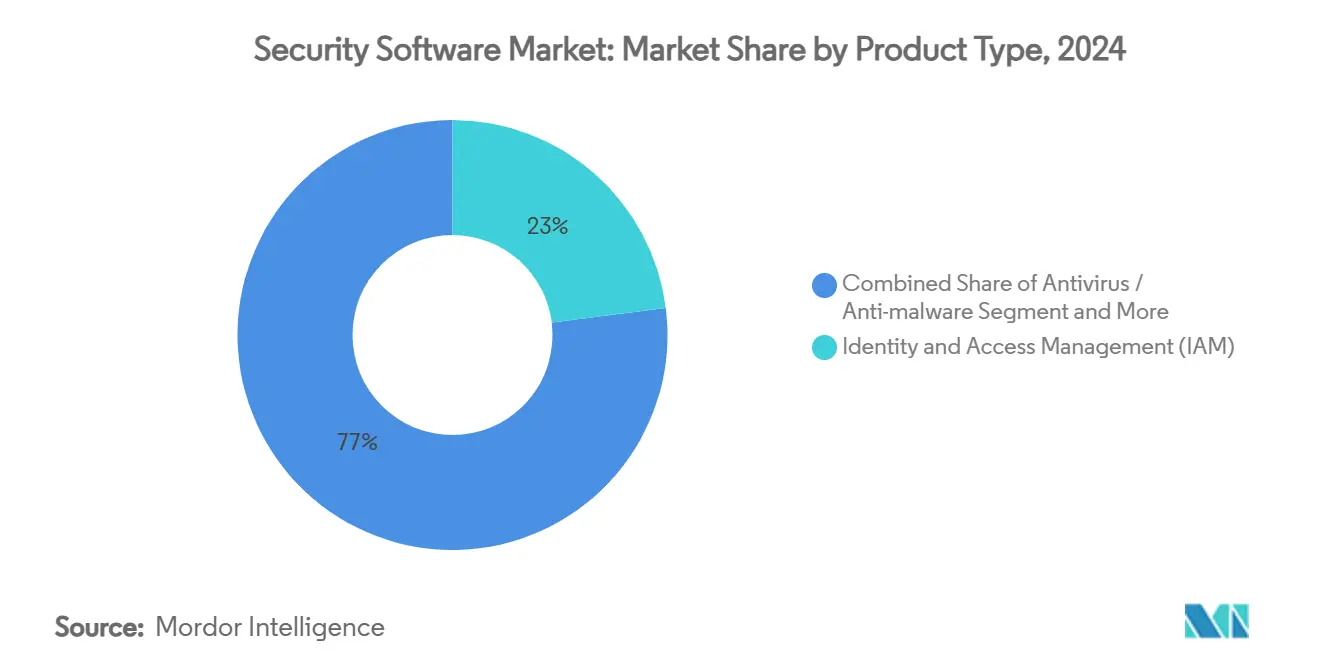
Note: Segment shares of all individual segments available upon report purchase
By Deployment Mode: Cloud Delivery Becomes Default
Cloud-based deployments captured 62% revenue in 2024. Organizations cite elastic scalability, continuous feature updates, and opex budgeting benefits. The security software market size for cloud-delivered solutions is projected to climb at an 18.55% CAGR, reaching USD 76 billion by 2030. Hybrid models remain vital for regulated workloads; hence leading vendors release on-premises gateways that forward logs to cloud analytics engines for central oversight.
The shift pushes vendors to decouple control planes from data planes, enabling enforcement across container clusters, edge nodes, and SaaS APIs under one policy set. Subscription bundles combining secure access service edge (SASE), cloud access security broker (CASB), and web isolation are resonating, as they cut procurement cycles. On-premises share will gradually decline yet persist in defence, critical infrastructure, and sovereign cloud environments where data-locality rules require in-country processing.
By Enterprise Size: SMEs Fuel Next Wave of Adoption
Large corporations still drive 67% of licence revenue, but growth momentum is migrating to SMEs. The security software market is seeing 14.9% SME CAGR because pay-as-you-go models remove capex barriers. Cloud dashboards that auto-discover assets and recommend best-practice policies simplify deployments for resource-constrained teams.
Platform vendors tailor SKUs with minimal click-through configuration, templated compliance reports, and 24/7 managed detection supported by regional SOCs. This democratization reduces dwell time for attackers across the broader ecosystem, indirectly protecting supply chains that depend on smaller suppliers.
By Application: Service-Based Consumption Accelerates
Enterprise and data-center use cases generated 54% of 2024 spend, but Security-as-a-Service offerings post the highest 19.4% CAGR. Buyers appreciate predictable operating costs and instant access to new modules such as vulnerability prioritization and threat-hunting assistance. Mobile security demand is steadily increasing as remote work normalizes, sustaining endpoint-centric growth inside the security software market.
Consumer suites blur with enterprise mobility management through bring-your-own-device (BYOD) policies. Vendors embed privacy-preserving telemetry collection to satisfy stringent data-handling expectations while maintaining analytics accuracy.
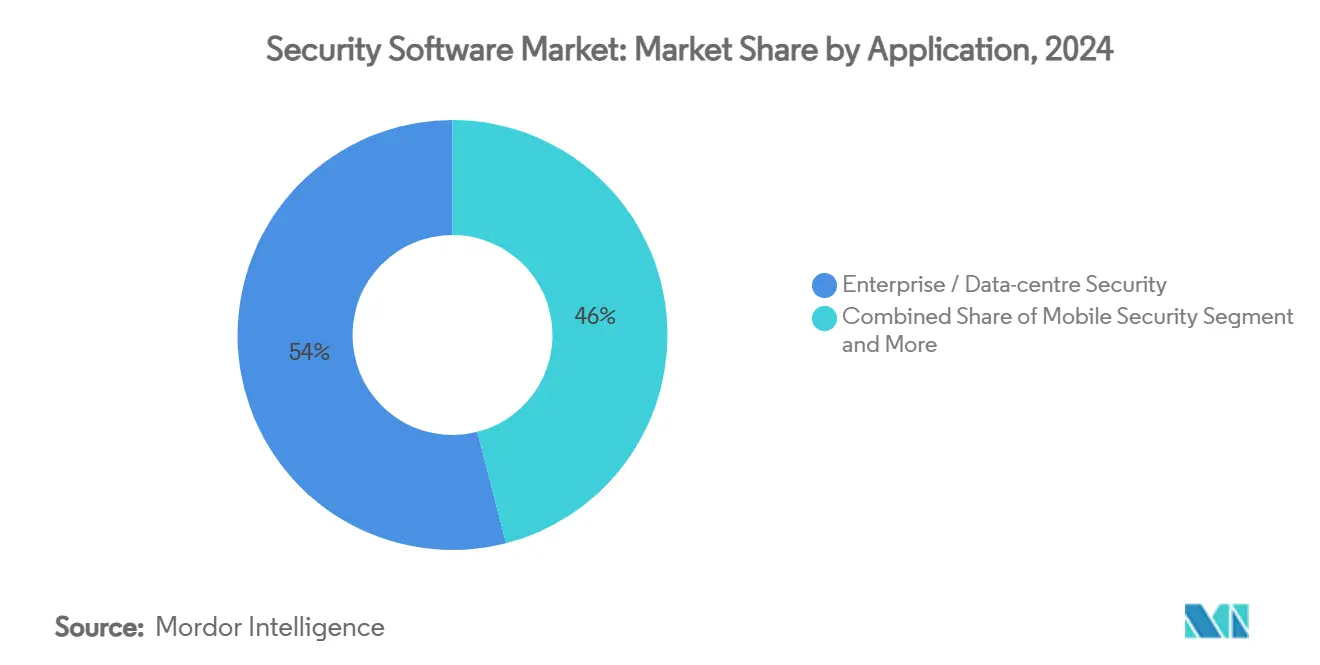
Note: Segment shares of all individual segments available upon report purchase
By End-use Industry: Compliance-Driven Sectors Lead
BFSI remains the top vertical at 26% revenue share, enforced by DORA and stringent transaction integrity requirements. Healthcare is the fastest riser, predicted to grow at 15.6% CAGR as electronic health records expand and connected medical devices proliferate. Manufacturers invest heavily in industrial control system (ICS) security to reduce downtime risks; energy firms add anomaly-detection layers across SCADA networks.
Retail and e-commerce prioritize payment tokenization and account takeover prevention, whereas telecom operators function both as buyers and service providers, embedding security into 5G core and edge offerings. This cross-industry demand sustains strong competitive dynamics throughout the security software market.
Geography Analysis
North America dominated with 38% revenue in 2024, supported by the USD 27.5 billion 2025 federal cybersecurity budget. Public-private data-sharing initiatives and a vibrant vendor ecosystem accelerate early adoption of AI-driven analytics. High breach disclosure penalties under U.S. SEC rules further encourage proactive investment.
Europe benefits from harmonized legislation such as the NIS2 Directive and Cyber Resilience Act, providing unified benchmarks for incident response and secure development. Vendors offering built-in multilingual compliance workflows gain traction, especially among pan-EU financial institutions.
The Middle East posts the fastest 14.8% CAGR, spurred by sovereign digital-economy ambitions. Saudi Arabia’s cybersecurity market reached SAR 13.3 billion (USD 3.5 billion) in 2025. National regulations mandate local data centers and breach notification within hours, compelling rapid software upgrades. Meanwhile, Asia-Pacific governments invest in joint security centers to mitigate quantum risks and state-sponsored attacks, positioning the region as a significant growth frontier for the security software market. [3]National Cybersecurity Authority, “Saudi Arabia Cybersecurity Outlook 2025,” nca.gov.sa
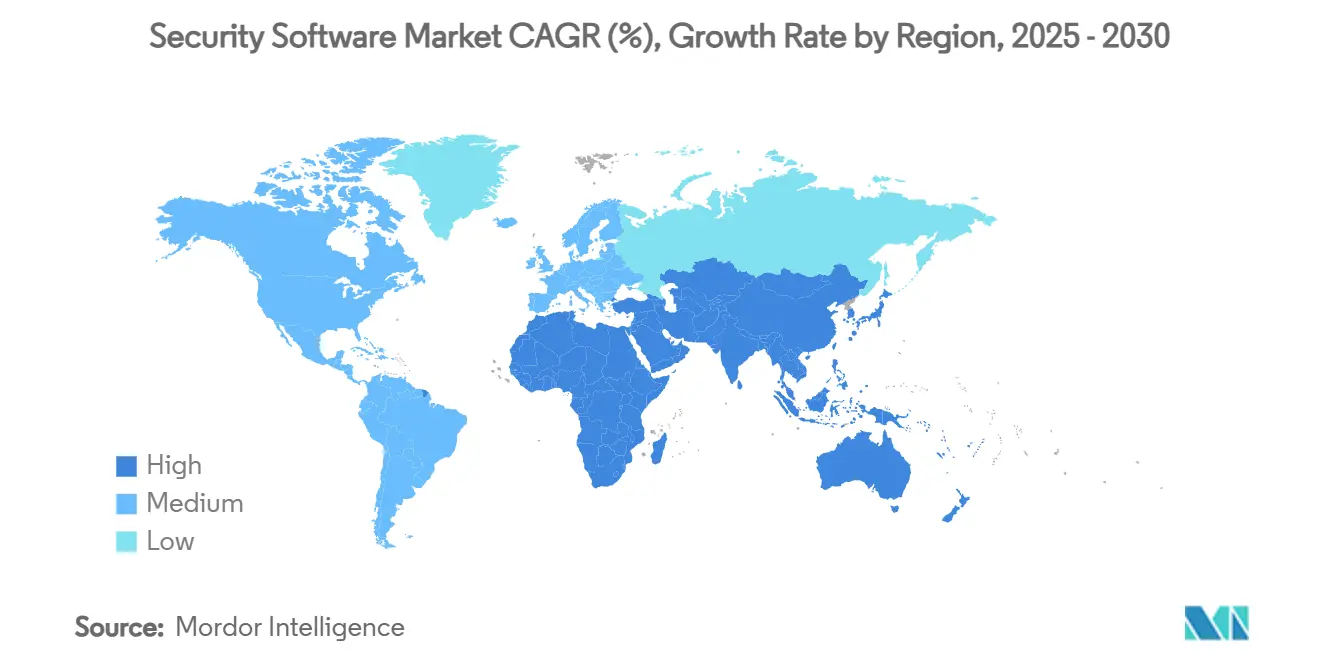
Competitive Landscape
The vendor universe remains moderately fragmented. Established players such as CrowdStrike, Palo Alto Networks, and Fortinet expand through acquisitions, bundling endpoint, identity, and network modules into single subscription SKUs. CrowdStrike’s 20% year-over-year revenue increase in Q1 FY2026 underscores demand for unified cloud platforms.
Smaller innovators carve niches in quantum-safe cryptography, attack surface management, and AI-based anomaly detection. Partnerships between hyperscale cloud providers and security specialists shorten integration cycles, further raising entry barriers for standalone point products. Competitive differentiation increasingly hinges on machine-learning model transparency, low false-positive rates, and native integration with DevOps pipelines.
Price competition is most acute in mid-market SASE and email security segments. Vendors that deliver outcome-based SLAs backed by insurance cover stand out. Overall, rising customer preference for consolidation steers the security software market toward a platform play, yet specialist disruptors continue to command premium valuations in strategic areas such as post-quantum key management and OT segmentation. [4]CrowdStrike Holdings Inc., “Q1 FY2026 Shareholder Letter,” crowdstrike.com
Security Software Industry Leaders
-
Microsoft Corporation
-
Cisco Systems, Inc.
-
Palo Alto Networks, Inc.
-
Fortinet, Inc.
-
Broadcom Inc. — Symantec Enterprise Division
- *Disclaimer: Major Players sorted in no particular order
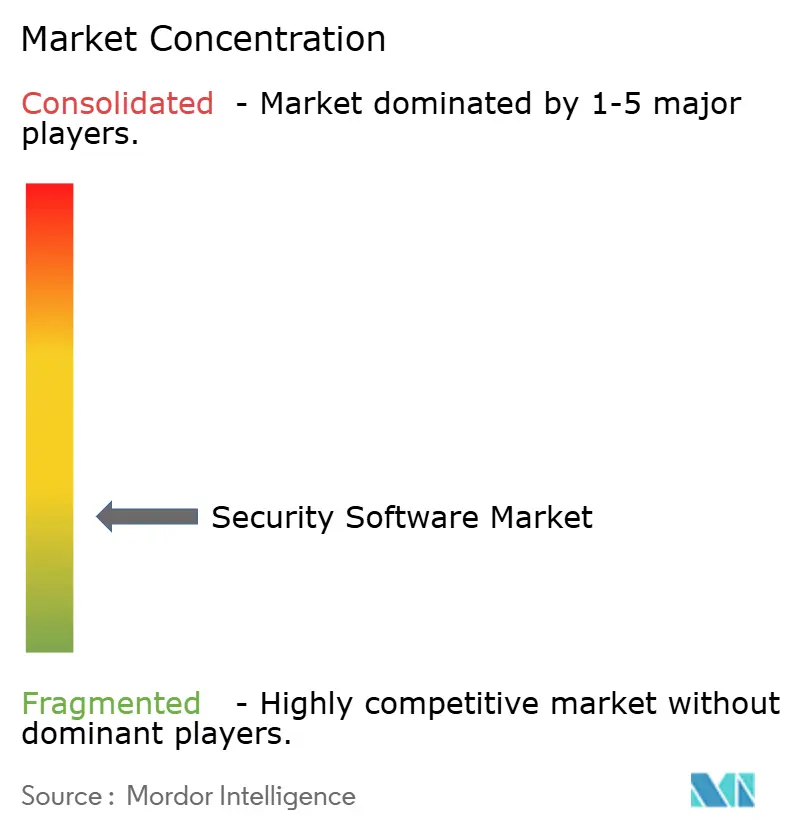
Recent Industry Developments
- June 2025: CrowdStrike reported Q1 FY2026 revenue of USD 921 million, a 20% year-over-year rise, driven by Falcon platform uptake.
- June 2025: Fortinet posted USD 1.54 billion Q1 2025 revenue and noted 25.7% ARR growth in its Unified SASE segment.
- May 2025: Palo Alto Networks achieved USD 2.29 billion Q3 2025 revenue, emphasizing AI-powered consolidation gains.
- April 2025: Check Point recorded 14% product revenue growth, citing strong Quantum Force appliance demand.
Global Security Software Market Report Scope
The security software market encompasses a broad range of solutions designed to protect digital assets, systems, and networks from cyber threats. It includes tools like antivirus software, firewalls, encryption programs, endpoint protection, and identity management systems. These solutions are critical for safeguarding sensitive data, ensuring compliance with regulatory standards, and mitigating risks posed by cyberattacks. The market serves various sectors, including BFSI, healthcare, IT, and government, driven by the increasing complexity of cyber threats and growing digital transformation.
The Security Software Market is segmented by type (antivirus/anti-malware software, firewall software, encryption software, identity and access management (IAM), endpoint security, network security software, and other type), deployment (on-premise, cloud, hybrid), enterprise size (large enterprise, small and medium enterprise), application (mobile security software, consumer security software, enterprise security software), end-use industry (aerospace and defense, energy and utility, BFSI, healthcare, retail, chemical, telecommunication, manufacturing, and other end-use industries) and geography (North America, Europe, Asia Pacific, Latin America, Middle East And Africa). the market sizes and forecasts are provided in terms of value (USD) for all the above segments.
| Antivirus / Anti-malware |
| Firewall and UTM |
| Encryption Software |
| Identity and Access Management (IAM) |
| Endpoint-protection Platform (EPP / EDR) |
| Network Security Platforms |
| Other Types |
| On-premise |
| Cloud-based |
| Hybrid |
| Large Enterprises |
| Small and Medium Enterprises (SME) |
| Mobile Security |
| Consumer Security Suites |
| Enterprise / Data-centre Security |
| BFSI |
| Healthcare |
| Retail and e-Commerce |
| Manufacturing |
| Energy and Utilities |
| Aerospace and Defence |
| Telecommunications |
| Government and Public Sector |
| Others |
| North America | United States |
| Canada | |
| Mexico | |
| Europe | United Kingdom |
| Germany | |
| France | |
| Italy | |
| Rest of Europe | |
| Asia-Pacific | China |
| Japan | |
| India | |
| South Korea | |
| Rest of Asia-Pacific | |
| Middle East | Israel |
| Saudi Arabia | |
| United Arab Emirates | |
| Turkey | |
| Rest of Middle East | |
| Africa | South Africa |
| Egypt | |
| Rest of Africa | |
| South America | Brazil |
| Argentina | |
| Rest of South America |
| By Product Type | Antivirus / Anti-malware | |
| Firewall and UTM | ||
| Encryption Software | ||
| Identity and Access Management (IAM) | ||
| Endpoint-protection Platform (EPP / EDR) | ||
| Network Security Platforms | ||
| Other Types | ||
| By Deployment Mode | On-premise | |
| Cloud-based | ||
| Hybrid | ||
| By Enterprise Size | Large Enterprises | |
| Small and Medium Enterprises (SME) | ||
| By Application | Mobile Security | |
| Consumer Security Suites | ||
| Enterprise / Data-centre Security | ||
| By End-use Industry | BFSI | |
| Healthcare | ||
| Retail and e-Commerce | ||
| Manufacturing | ||
| Energy and Utilities | ||
| Aerospace and Defence | ||
| Telecommunications | ||
| Government and Public Sector | ||
| Others | ||
| By Geography | North America | United States |
| Canada | ||
| Mexico | ||
| Europe | United Kingdom | |
| Germany | ||
| France | ||
| Italy | ||
| Rest of Europe | ||
| Asia-Pacific | China | |
| Japan | ||
| India | ||
| South Korea | ||
| Rest of Asia-Pacific | ||
| Middle East | Israel | |
| Saudi Arabia | ||
| United Arab Emirates | ||
| Turkey | ||
| Rest of Middle East | ||
| Africa | South Africa | |
| Egypt | ||
| Rest of Africa | ||
| South America | Brazil | |
| Argentina | ||
| Rest of South America | ||
Key Questions Answered in the Report
What is the current size of the security software market?
The market is worth USD 65.25 billion in 2025 and is projected to reach USD 108.96 billion by 2030.
Which segment holds the largest security software market share?
Identity and Access Management leads with 23% share in 2024.
How fast are cloud-based security deployments growing?
Cloud-delivered solutions are expanding at an 18.55% CAGR through 2030.
Why is the Middle East the fastest-growing regional market?
National digital transformation programs and strict data-sovereignty rules are driving a 14.8% CAGR in the region.
What impact does the EU Digital Operational Resilience Act have on vendors?
DORA obliges financial institutions to adopt 24-hour incident reporting and robust third-party oversight, boosting demand for compliant security platforms.
How are cyber-insurance requirements influencing software adoption?
Underwriters increasingly demand certified security controls, prompting enterprises to invest in automated compliance and endpoint protection suites to secure favourable premiums.
Page last updated on:
